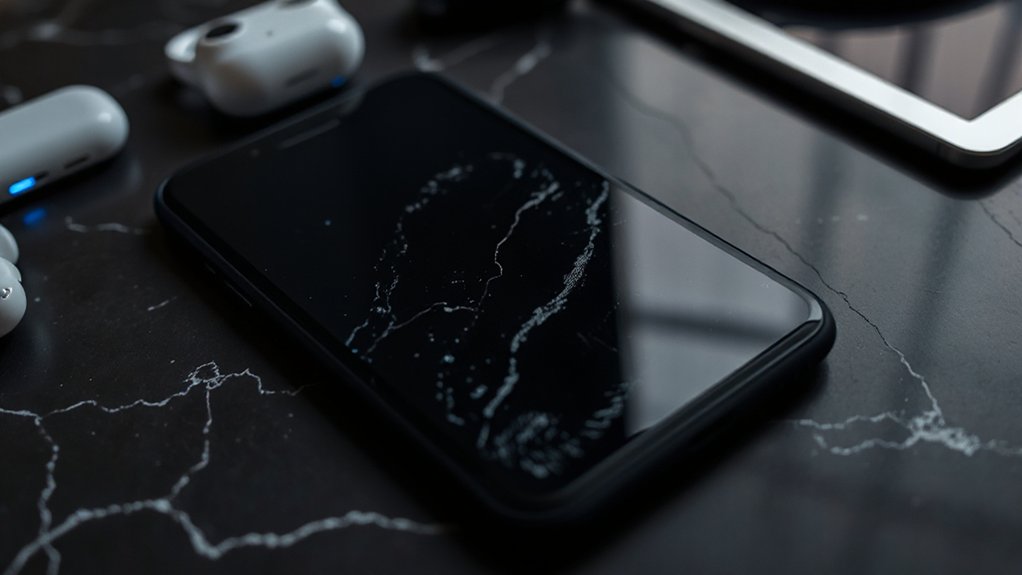Modern infidelity generates extensive digital evidence through automated smartphone data collection, location tracking, and cloud storage systems. Deleted communications remain recoverable through forensic analysis, while metadata from photos and social media posts creates discoverable timelines. Smart devices log behavioral patterns, financial transactions establish audit trails, and app permissions enable continuous monitoring of user activities. Network providers maintain permanent location logs even when settings appear disabled. Understanding these technological vulnerabilities reveals how digital breadcrumbs expose concealed activities through thorough data analysis.
Key Takeaways
- Smartphones automatically collect location data and communication logs even when users believe tracking is disabled or deleted.
- Cloud providers retain multiple copies of deleted messages, photos, and data for extended periods despite user deletion attempts.
- Digital transactions create permanent audit trails revealing suspicious spending patterns like unexplained hotel bookings and restaurant charges.
- Smart home devices and voice assistants generate activity logs documenting behavioral changes and storing conversations in cloud databases.
- Social media platforms preserve metadata from deleted posts, allowing forensic specialists to reconstruct hidden activity timelines and communications.
The Smartphone Surveillance System in Your Pocket

Modern smartphones function as extensive surveillance devices that continuously collect, store, and transmit location data, communication logs, and behavioral patterns. These digital archives create thorough records of intimate encounters through multiple tracking mechanisms that most users never fully disable.
App permissions grant access to cameras, microphones, contacts, and location services, often running background processes that log activity timestamps and geographic coordinates. Dating applications, messaging platforms, and social media services maintain detailed interaction histories, including deleted conversations and photo metadata.
Notification settings reveal relationship dynamics through message frequency patterns and response times. Cloud synchronization automatically backs up intimate photos, call logs, and text exchanges across multiple devices. Browser histories, autocomplete suggestions, and saved passwords create additional evidence trails that persist despite surface-level deletion attempts. Notably, the use of digital forensics has become essential in uncovering data that users believe to be deleted or inaccessible.
Cloud Storage Betrayals: When Deleted Doesn’t Mean Gone
Although users believe deleting files removes them permanently, cloud storage systems retain multiple copies of data across distributed servers for weeks, months, or even years after deletion. These backup protocols create unexpected vulnerabilities for those attempting to conceal intimate communications or compromising photographs.
Major cloud providers implement redundant storage architectures where deleted content persists in backup databases, sync logs, and version histories. Professional data recovery specialists can extract these remnants using forensic tools that access server-side caches and metadata repositories. Proper evidence handling is essential in such cases to ensure the integrity of the data extracted.
Automated cloud sharing features compound exposure risks by creating additional copies across linked devices and accounts. When intimate partners share family accounts or connected devices, deleted files often resurface through synchronized folders, shared albums, or backup restoration processes that users never realized were active.
Location Services: The GPS Trail That Never Lies
While individuals may disable location tracking in their device settings, smartphones continuously log GPS coordinates through multiple background services that operate independently of user preferences. Network providers maintain location logs for emergency services, creating permanent records of tower connections. Apps retain cached location data even after permissions are revoked, storing coordinates in hidden databases. Modern GPS accuracy reaches within three meters, documenting precise movements between specific addresses, hotels, or meeting locations. Google Timeline and Apple’s Significant Locations compile detailed movement patterns spanning months or years. These services automatically categorize frequent destinations, revealing patterns that contradict stated whereabouts. Location metadata embeds in photos, social media posts, and ride-sharing receipts, creating multiple verification points that establish thorough geographic timelines impossible to completely erase. Additionally, expert investigations can stop alimony payments by providing necessary evidence of cohabitation through surveillance techniques.
Social Media Metadata: Hidden Digital Timestamps

Every photograph, status update, and message posted across social media platforms carries embedded metadata that functions as an immutable digital timestamp, recording precise creation dates, device information, and geographic coordinates regardless of privacy settings. This invisible data layer reveals the authentic chronology of digital interactions, often contradicting carefully constructed alibis. Social media analytics tools can extract this information from seemingly innocent posts, exposing discrepancies between claimed whereabouts and actual activities.
While timestamp manipulation techniques exist, they require technical expertise that most users lack. The metadata persists even when posts are deleted, archived in platform databases and forensic recovery systems. Partners conducting investigations can access specialized software that reveals when photos were actually taken versus when they were shared, creating an unforgiving timeline of deceptive behavior that transcends surface-level privacy controls. Notably, awareness of repossession dynamics can aid individuals in understanding the implications of digital footprints in relation to financial accountability.
App Activity Patterns That Reveal Secret Behaviors
When examining smartphone usage analytics, investigators can identify distinctive behavioral patterns that signal clandestine activities through systematic analysis of application engagement metrics. App usage data reveals temporal anomalies when communication platforms show increased activity during previously inactive periods. Notification history exposes deleted conversations through timestamp gaps and frequency changes. Hidden applications often require modified app permissions that create forensic markers in system logs. Cross device synchronization creates data trails across multiple platforms, revealing coordinated deception efforts. Tracking apps disguised as utility programs generate distinctive battery drain patterns and background data consumption. Usage anomalies include messaging apps with disabled notifications, photo applications with restricted cloud backup, and communication platforms operating in stealth modes. These behavior patterns form exhaustive digital signatures that expose secretive activities through quantifiable evidence. Additionally, digital evidence analysis can uncover further insights into communication and usage trends that may indicate infidelity.
Smart Home Devices as Silent Witnesses
Smart home ecosystems generate extensive activity logs that document residential movements and behavioral patterns with forensic precision. Connected thermostats record temperature adjustments during unusual hours, revealing presence patterns inconsistent with stated schedules. Smart locks timestamp entry and exit events, creating irrefutable chronologies of comings and goings that contradict alibis.
Voice assistant eavesdropping capabilities capture ambient conversations and commands, storing fragments in cloud databases accessible through account histories. These devices inadvertently document intimate moments, arguments, and phone calls that reveal relationship dynamics. Security camera insights provide visual evidence of visitors, duration of stays, and behavioral changes within supposedly private spaces.
Motion sensors, smart lighting systems, and connected appliances collectively paint detailed pictures of domestic routines. When patterns deviate markedly from established baselines, these silent digital witnesses create thorough evidence trails that expose deceptive behaviors through objective data analysis. Furthermore, effective investigations into these digital footprints can reveal critical insights into potential misconduct and support accountability.
Financial Transaction Records in the Digital Age
While cash transactions leave minimal traces, digital financial activities create extensive audit trails that expose clandestine spending patterns and undisclosed relationships. Modern banking systems meticulously record every purchase, transfer, and withdrawal with precise timestamps and merchant details. Online banking platforms maintain thorough histories accessible to authorized parties during investigations or legal proceedings.
Credit card statements reveal hotel bookings, restaurant charges, and gift purchases that contradict stated whereabouts or intentions. Even sophisticated attempts at financial obfuscation through cryptocurrency tracking demonstrate that blockchain technologies create permanent, immutable records. Digital wallets, payment apps, and automated transfers establish clear spending patterns that forensic analysts can decode.
Financial institutions’ data retention policies guarantee these digital breadcrumbs persist for years, creating an indelible record of monetary decisions that often illuminate hidden activities and undisclosed romantic entanglements. Moreover, understanding fraud risk assessments can further enhance the detection of suspicious financial behaviors through continuous monitoring and evaluation.
Frequently Asked Questions
Can Cheating Partners Legally Access My Digital Devices Without My Permission?
Accessing another person’s digital devices without explicit permission constitutes a violation of privacy laws in most jurisdictions. Device permissions require clear consent from the owner, regardless of relationship status. Consent laws typically do not recognize romantic partnerships as grounds for unauthorized access to phones, computers, or accounts. Such actions may result in criminal charges including unauthorized computer access, invasion of privacy, or digital trespassing violations.
How Long Do Internet Service Providers Keep Records of Browsing History?
Internet service providers typically maintain browsing data retention for 12-24 months, though some extend this to several years depending on jurisdiction and internal policies. ISP privacy policies vary greatly between providers and regions, with some required by law to store connection logs, timestamps, and destination addresses. Users should examine their specific provider’s data retention schedule, as this information remains accessible to legal proceedings and authorized investigations throughout the retention period.
Do Privacy Settings on Social Media Actually Protect Against Digital Discovery?
Social media privacy settings provide limited protection against digital discovery. Privacy controls only restrict public visibility, not platform data retention or legal subpoenas. Partners with device access can bypass most protections through saved passwords or cached content. Social media privacy configurations cannot eliminate metadata trails, location stamps, or synchronized messaging across platforms. Extensive digital footprint awareness reveals that privacy settings create false security rather than genuine protection against determined investigation.
Can Deleted Text Messages Be Recovered by Phone Companies or Investigators?
Yes, deleted messages can often be recovered through data recovery methods. Phone companies typically maintain message retention policies storing texts for 90 days to several years for billing and legal compliance. Law enforcement investigators can obtain court orders to access carrier records. Additionally, messages may persist in device backups, cloud storage, or recipient phones even after deletion from the sender’s device, creating multiple recovery pathways.
What Legal Rights Do I Have if Someone Monitors My Digital Activity?
Digital privacy rights vary considerably by jurisdiction and relationship status. Unauthorized monitoring typically violates wiretapping laws, computer fraud statutes, and privacy regulations. Married individuals face complex legal landscapes where spousal monitoring exists in gray areas. Legal consequences for perpetrators include criminal charges, civil liability, and restraining orders. Evidence gathered through illegal surveillance often becomes inadmissible in court proceedings, potentially undermining the monitor’s intended objectives.
Conclusion
Modern cheating investigations increasingly depend on comprehensive digital forensics rather than traditional surveillance methods. The combination of smartphone data, cloud storage syncing, GPS location tracking, file metadata analysis, behavioral pattern recognition, smart device logs, and financial transaction monitoring creates a detailed evidence foundation. Digital traces remain across multiple connected systems, often surviving deletion through automatic backup systems. Today’s investigation approaches must consider this complex digital evidence environment when piecing together behavior patterns and establishing chronologies.
Let us Help
Stillinger Investigations, Inc.
170 Meeting St, Charleston, SC 29401
843-212-1338







